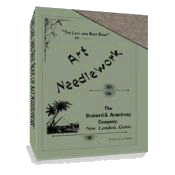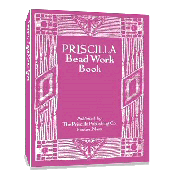Seed Embroidery
Is It What You Think It Is?

Seed embroidery is one of the few embroideries that does NOT take its name from an embroidery stitch. The seed stitch is a simple stitch to resemble a small seed. This type of embroidery actually USES seeds of all sizes to make the designs. I can only imagine the time it took to do such embroidery!
Here is some interesting information about this embroidery. It was not widely practiced, and after reading how to do it, I can understand why. The patience one must have had to have to do such an art is astounding.
The information below was published in The Dictionary of Needlework: An Encyclopedia of Artistic, Plain, and fancy Needlework, by S.F.A. Caulfeild and Blanche C. Saward in 1882. It has been edited for use on this site.
Seed Embroidery
Seed Embroidery was practiced in Germany, but not much known in England. It was formed by making flowers and buds with various seeds, and connecting these together with stems and stalks of Chenille, and working the leaves in Chenille. The seeds used for the work are those of the Indian corn, pumpkin, and cucumber, for large flowers, and canary and aster for the small. These seeds are pierced at each end with a carpet needle, and attached by these holes to the material.
To work: Select a Crewel Work design of single flowers, such as daisies, sunflowers, or marigolds, and seeds that match the size of the petals, also Chenilles of various shades of green, and sewing and purse silk matching the flowers.
Trace the design upon white or pale colored blue satin, back it with Holland, and frame it in an embroidery frame.
Pierce the seeds at the top and bottom, and sew them to their places, either as flat petals, when lay them flat upon the satin, and secure with a stitch, made in sewing silk, at each of their ends; or as raised, when place them upright upon the satin, sew them together, and then down to the material.
Having placed the seeds, work the centers of the flowers in French Knots with the purse silk, and the stems, stalks, and leaves in the green Chenille and in Satin Stitch.
The Embroidery is used for sachets, hand bags, and fire screens. Necklaces and bracelets are made of melon or pumpkin seeds, by threading them upon fine silk, and forming them into balls, chains, tassels, and other devices.
A Sample of Seed Embroidery
To give an another idea on how this embroidery was used and what it might look like, I have included a project below that was commonly made. Of course, any box may be used if a cigar box is not available. As you will see, very little instructions were actually given. It was assumed the embroiderer would know what to do or be able to read between the lines using their past experience with needlework to complete the project.
This project is from the same book as cited above and has been edited for this site as well.

Seed Embroidery for Cigar Case
This embroidery project is worked upon brown rep silk. The flowers are formed of small seeds, and the sprays and leaves with green and brown chenille, worked in Satin Stitch.
I can honestly say this is probably one embroidery I will not try as it is so time consuming and meticulous work must be done. Has anyone of you reading tried this? If so, please share your project. I would absolutely LOVE to see one in color.
Return to top of Seed Embroidery page.
Return to Types of Embroidery page.
The Last and Best Book of Art Needlework
Over 100 pages of authentic Victorian instructions and patterns from 1895!
FREE
Beeton's Book Of Needlework

433 pages!
Sign up for VEAC! Everything you wanted to know about Victorian embroidery, needlework, crafts and more!
Priscilla Bead Work Book
Make Beautiful Victorian Beaded Purses, Jewelry & Accessories - Starting
TODAY!



